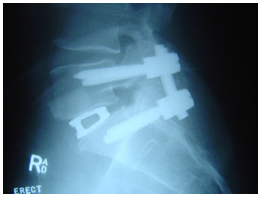In Hospital
 Upon return to the ward after surgery an IV drip, a wound drain and an epidural infusion (small tube going into the back) will be noticed. There may also be a bladder catheter in place. The epidural infusion is generally very effective at relieving the pain of the surgery, however additional pain relieving medication will also be made available if required. Additional oxygen (usually by small nose inserts) is a requirement when an epidural infusion is in place. Ward nursing staff will frequently make routine checks and observe the function of the legs. TED (Thrombo-Embolic Deterrent) stockings will be in place and should be worn for 6 weeks after the operation in order to avoid blood clotting in the legs.
Upon return to the ward after surgery an IV drip, a wound drain and an epidural infusion (small tube going into the back) will be noticed. There may also be a bladder catheter in place. The epidural infusion is generally very effective at relieving the pain of the surgery, however additional pain relieving medication will also be made available if required. Additional oxygen (usually by small nose inserts) is a requirement when an epidural infusion is in place. Ward nursing staff will frequently make routine checks and observe the function of the legs. TED (Thrombo-Embolic Deterrent) stockings will be in place and should be worn for 6 weeks after the operation in order to avoid blood clotting in the legs.
Patients are encouraged to walk around their immediate environment with the assistance of our physiotherapist on the day following surgery. A corset will be provided which will help to ease the lower back discomfort when walking. The corset should be used for 6 weeks following the operation.
On the day following surgery the wound drain will generally be removed. A diet may be taken as required. The physiotherapist will call again to assist in mobilisation and to provide exercises which help to prevent blood clotting. An x-ray of the back may be required.
On the second day following surgery the epidural infusion (and therefore the IV drip, the oxygen and the bladder catheter) will usually be removed. As the epidural has generally been very effective at relieving the pain of the operation, the level of pain may increase somewhat following its removal. Additional painkillers either by tablet or injection are made available for use as required.
The hospital stay is usually 4 or 5 days and is determined by the patient's ability to walk without assistance after the operation. A clear rubbery wound dressing is applied which will remain in place for 2 weeks. This dressing is water resistant and showers may be taken, however the wound should not be immersed (bath, swimming pool) for the first fortnight. It is safe to travel home as a front seat passenger with the seat near-fully reclined and wearing a seat belt. Driving should be avoided for 6 weeks after the surgery.
At Home
In the first few days following the surgery the back may be stiff and uncomfortable. This is quite usual and reflects the recent surgery. Leg pain of the type which was present before the operation may also be present however should not be as severe as it was previously. "Pins and needles" in the leg may also be experienced. This may result from either the previous pressure on the spinal nerve or from its manipulation during surgery and is quite common. Again, the leg pain should not be as severe as it was before the operation and in the vast majority of cases will subside prior to the 6 week postoperative consultation. The pain may be treated with simple "over the counter" pain relievers however, if persistent, Assoc. Professor Richard Williams' rooms should be contacted for further advice.
At 2 weeks following the day of surgery a visit to the local general practitioner should be made for removal of the wound dressing so that satisfactory healing may be confirmed. The sutures are under the skin and do not need removal.
Activity should recommence gradually:
- In the first 2 weeks, activity should be confined largely to the home and involve only personal hygiene and minor tasks involving no exertion.
- From 2 weeks (the time of wound dressing removal) to 4 weeks a gentle exercise program may be instituted. This will include activities such as gentle walks around the neighbourhood, swimming or use of an exercise bike. The exercise program provided by our physiotherapist will also be in place.
- At 4 weeks after the operation, general household duties (without bending or lifting!) may be recommenced and the exercise program stepped up.
In a non-manual occupation, work could recommence at 4 weeks. In a manual occupation 6 weeks away from work will be required. Wherever possible, recommencement at work for both manual and non-manual workers is most desirable in half days for the first week, after which full active duty may be undertaken.
The first postoperative visit with Assoc. Professor Richard Williams is usually at the 6 week mark (or just prior to recommencement at work). Those patients requiring an x-ray at this visit should arrive for the appointment 30 minutes prior to the appointment time - this will be made known to the patient when the appointment is made.
At any time in the postoperative course Assoc. Professor Richard Williams is available to answer questions or give advice regarding any difficulty which is being experienced.
